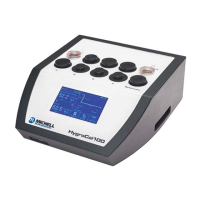HygroCal100 User’s Manual
Michell Instruments
29
OPERATION
The time taken for the chamber to respond to the set point is shown in red fi ll - this is
not included in the duration for that set point, which is shown in blue fi ll.
When the step change in humidity is large, the chamber will take longer to reach the set
point. It will typically take much longer to dehumidify than to humidify, so the transition
from 30% to 50% will be quicker than 50% to 30%.
3.9 Operating Practice
To perform a reliable humidity validation, it is important to follow these basic guidelines:
When starting a validation routine, ensure that the temperature of the environment
you intend to operate in is stable, and that the HygroCal100 has been in the stable
environment for enough time to reach temperature equilibrium with its surroundings.
If the HygroCal100 is not allowed time to stabilize with its environment, then the
conditions that each probe under test experiences may not be the same. Due to the
key infl uence temperature has on determining relative humidity, validation errors would
result.
For example, at an ambient of 23°C and a set point of 40%RH, a difference of 0.5°C
could affect the RH by up to 1.25%. At lower humidities the difference can be even
more signifi cant.
When running a validation routine, it is usually advisable to start with the driest points
fi rst and increase the humidity.
There are several benefi ts to this:
• Speed of transition - it is much quicker for the chamber to add humidity
than to remove it, therefore a validation running from dry to wet will
require shorter transition and stabilization times than one running from
wet to dry.
• Service life of desiccant - repeatedly asking the chamber to dehumidify
will result in a much shorter desiccant lifetime than if the cycle is run so
that humidity only needs to be added.
Always ensure, when installing probes into the chamber, that the port adaptor used is
of the correct diameter for the probe body, so that there are no potential leak points.

